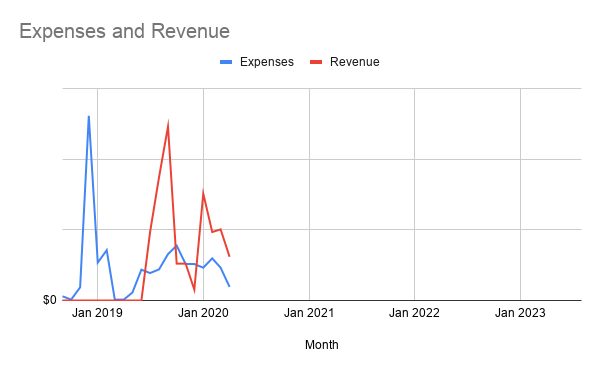A simple tool for bootstrapped startup
For the need of the Founders Kitchen Sink (FKS) project, where I am demonstrating how to bootstrap SaaS, I had to create a budget forecast for the project I’m building. I’ve tried to use existing tools available but found that they are created for funded startups, whereas bootstrapping is a different game, and budget tools did not apply to my situation.

I’ve decided to create a robust, simple tool that will help me to understand what is the timeline of the project from the financial perspective. I am aware that forecasts require a lot of factors to be considered, such as churn rate, for example. Yet I’ve divided it to make it primitive, where fundamental factors are number of customers, number of subscription plans and their price. These factors draw a picture of possible income, where I can easily create pessimistic and optimistic scenarios.
Expenses and revenue
When it comes to expenses, I’ve used figures I’ve explained in the previous episode of FKS, where I’ve covered the required budget that is necessary to build Minimum Viable Product. Because I wanted to create a five years forecast, the challenge appeared in predicting expenses that will come after creating the MVP. I’ve used my experience and knowledge and made assumptions about the cost structure. The main difference between a bootstrapped startup and funded one is that when bootstrapping, the founder does not earn any money in terms of salary. The salary structure appears after a time when the project makes the revenue. It is very important to have in mind when looking at such predictions as these may give a false image of that to expect.
The parameters I’ve set are:
- Two subscription plans:
- “Basic” for $40/month
- “Advanced” for $80/month, it will be available after a year from launch the MVP.
- The growth factor. For the Basic plan it will be 5%, and 1% of growth for the Advanced plan.
Forecast results
I’ve created this tool in Google Sheets. With the use of separate sheets for expenses and revenue, I’ve created a simple dashboard with two charts:

This chart reveals the predicted expenses and revenue. My tool assumes a linear growth of the customer base- the revenue function is not a brainer. The expenses function is more interesting. It looks like the expenses structure is more or less flat, kept at the same level for most of the time, with high costs at the very beginning of the project.

This chart is more attractive as it reveals the predicted income. On this chart, I should expect the income after three and a half years.
I think you would agree that these charts are too good to be true, so I’ve done a simple experiment where I’ve copy & paste the results of one of the SaaS projects I launched two years ago so compare how distant my forecast is from the reality. These two charts below show expenses vs revenue and income from the project that started in September 2018.

The expenses structure for the real-life example is more or less the same as in forecast- high cost at the beginning of the product life cycle, then becomes more or less flat. The significant difference is revenue. It is not that predictable as the forecast of the new project income, but there is a considerable difference: the real-life revenue includes yearly subscriptions. It means these peaks should be divided into 12 months.

The income function of the live product is very similar to a forecasted one. Yet, it broke even three times faster, as the expenses were lower and because customers purchased annual subscriptions.
Use it for free
I’ve intentionally removed the vertical axis legend because actual numbers are not the most important thing in this article. I just wanted to learn how much the forecast results would be different from real life. It looks like the tool provides somehow realistic results in terms of charts, but many factors have an impact on the final results. It cannot be used as an oracle whether to invest in the product or not but can give a general idea of what to expect.
If you would like to use this tool for your predictions or would like to learn what figures I’ve used, observe the Founders Kitchen Sink space. Next week I will publish this tool with comments.
